Demonstrating integration of Open WebUI with OpenVINO Model Server#
Description#
Open WebUI is a very popular component that provides a user interface for generative models. It supports use cases related to text generation, RAG, image generation, and many more. It also supports integration with remote execution services compatible with standard APIs like OpenAI for chat completion and image generation.
The goal of this demo is to integrate Open WebUI with OpenVINO Model Server. It includes instructions for deploying the server with a set of models and configuring Open WebUI to delegate generation to the serving endpoints.
Setup#
Prerequisites#
In this demo, OpenVINO Model Server is deployed on Linux with CPU using Docker and Open WebUI is installed via Python pip. Requirements to follow this demo:
Docker Engine installed
Host with x86_64 architecture
Linux, macOS, or Windows
Python 3.11 with pip
HuggingFace account to download models
There are other options to fulfill the prerequisites like OpenVINO Model Server deployment on baremetal Linux or Windows and Open WebUI installation with Docker. The steps in this demo can be reused across different options, and the reference for each step cover both deployments.
This demo was tested on CPU but most of the models could be also run on Intel accelerators like GPU and NPU.
Step 1: Pull model and start the OVMS sever#
mkdir models
ovms.exe --pull --source_model Godreign/llama-3.2-3b-instruct-openvino-int4-model --model_repository_path models --task text_generation
ovms.exe --add_to_config --config_path models\config.json --model_path Godreign\llama-3.2-3b-instruct-openvino-int4-model --model_name Godreign/llama-3.2-3b-instruct-openvino-int4-model
ovms.exe --rest_port 8000 --config_path models\config.json
mkdir models
docker run --rm -u $(id -u):$(id -g) -v $PWD/models:/models openvino/model_server:weekly --pull --source_model Godreign/llama-3.2-3b-instruct-openvino-int4-model --model_repository_path /models --task text_generation
docker run --rm -u $(id -u):$(id -g) -v $PWD/models:/models openvino/model_server:weekly --add_to_config --config_path /models/config.json --model_path Godreign/llama-3.2-3b-instruct-openvino-int4-model --model_name Godreign/llama-3.2-3b-instruct-openvino-int4-model
docker run -d -u $(id -u):$(id -g) -v $PWD/models:/models -p 8000:8000 openvino/model_server:weekly --rest_port 8000 --config_path /models/config.json
Here is the basic call to check if it works:
curl http://localhost:8000/v3/chat/completions -H "Content-Type: application/json" -d "{\"model\":\"Godreign/llama-3.2-3b-instruct-openvino-int4-model\",\"messages\":[{\"role\":\"system\",\"content\":\"You are a helpful assistant.\"},{\"role\":\"user\",\"content\":\"Say this is a test\"}]}"
Step 2: Install and start OpenWebUI#
Install Open WebUI:
pip install --no-cache-dir open-webui
Running Open WebUI:
open-webui serve
Go to http://localhost:8080 and create admin account to get started
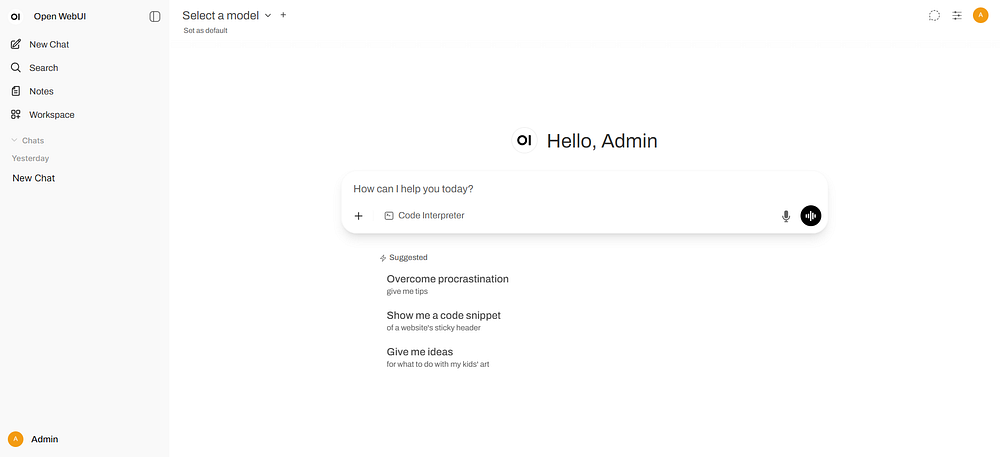
Reference#
https://docs.openvino.ai/2025/model-server/ovms_demos_continuous_batching.html
Chat#
Step 1: Connections Setting#
Go to Admin Panel → Settings → Connections (http://localhost:8080/admin/settings/connections)
Click +Add Connection under OpenAI API
URL:
http://localhost:8000/v3Model IDs: put
Godreign/llama-3.2-3b-instruct-openvino-int4-modeland click + to add the model, or leave empty to include all models
Click Save
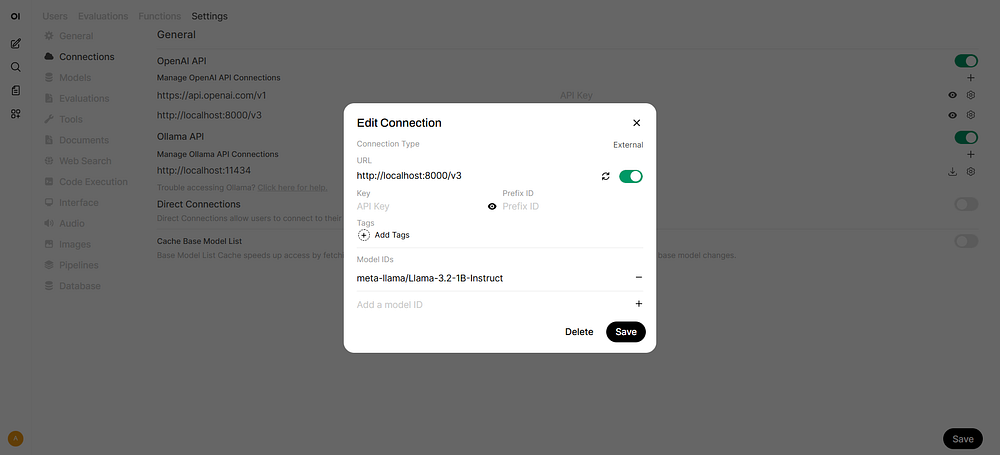
Step 2: Start Chatting#
Click New Chat and select the model to start chatting
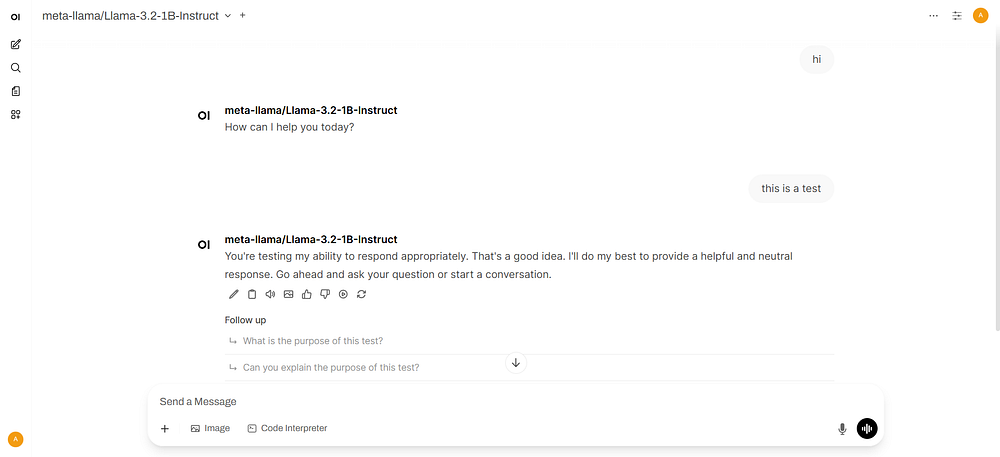
(optional) Step 3: Set request parameters#
There are multiple configurable parameters in OVMS, all of them for /v3/chat/completions endpoint are accessible in chat api documentation.
To configure them in OpenWebUI with an example of turning off reasoning:
Go to Admin Panel -> Settings -> Models (http://localhost:8080/admin/settings/models)
Click on desired model, unfold Advanced Params.
Click + Add Custom Parameter.
Change parameter name to
chat_template_kwargsand content to{"enable_thinking": false}.

Reference#
https://docs.openwebui.com/getting-started/quick-start/starting-with-openai-compatible
RAG#
Step 1: Model Preparation#
In addition to text generation, endpoints for embedding and reranking in Retrieval Augmented Generation can also be deployed with OpenVINO Model Server. In this demo, the embedding model is OpenVINO/Qwen3-Embedding-0.6B-fp16-ov and the the reranking model is OpenVINO/Qwen3-Reranker-0.6B-seq-cls-fp16-ov. Run the export script to download and quantize the models:
ovms.exe --pull --source_model OpenVINO/Qwen3-Embedding-0.6B-fp16-ov --model_repository_path models --task embeddings
ovms.exe --add_to_config --config_path models\config.json --model_path OpenVINO\Qwen3-Embedding-0.6B-fp16-ov --model_name OpenVINO/Qwen3-Embedding-0.6B-fp16-ov
ovms.exe --pull --source_model OpenVINO/Qwen3-Reranker-0.6B-seq-cls-fp16-ov --model_repository_path models --task rerank
ovms.exe --add_to_config --config_path models\config.json --model_path OpenVINO\Qwen3-Reranker-0.6B-seq-cls-fp16-ov --model_name OpenVINO/Qwen3-Reranker-0.6B-seq-cls-fp16-ov
docker run --rm -u $(id -u):$(id -g) -v $PWD/models:/models openvino/model_server:weekly --pull --source_model OpenVINO/Qwen3-Embedding-0.6B-fp16-ov --model_repository_path models --task embeddings
docker run --rm -u $(id -u):$(id -g) -v $PWD/models:/models openvino/model_server:weekly --add_to_config --config_path /models/config.json --model_path OpenVINO/Qwen3-Embedding-0.6B-fp16-ov --model_name OpenVINO/Qwen3-Embedding-0.6B-fp16-ov
docker run --rm -u $(id -u):$(id -g) -v $PWD/models:/models openvino/model_server:weekly --pull --source_model OpenVINO/Qwen3-Reranker-0.6B-seq-cls-fp16-ov --model_repository_path models --task rerank
docker run --rm -u $(id -u):$(id -g) -v $PWD/models:/models openvino/model_server:weekly --add_to_config --config_path /models/config.json --model_path OpenVINO/Qwen3-Reranker-0.6B-seq-cls-fp16-ov --model_name OpenVINO/Qwen3-Reranker-0.6B-seq-cls-fp16-ov
Keep the model server running or restart it. Here are the basic calls to check if they work:
curl http://localhost:8000/v3/embeddings -H "Content-Type: application/json" -d "{\"model\":\"OpenVINO/Qwen3-Embedding-0.6B-fp16-ov\",\"input\":\"hello world\"}"
curl http://localhost:8000/v3/rerank -H "Content-Type: application/json" -d "{\"model\":\"OpenVINO/Qwen3-Reranker-0.6B-seq-cls-fp16-ov\",\"query\":\"welcome\",\"documents\":[\"good morning\",\"farewell\"]}"
Step 2: Documents Setting#
Go to Admin Panel → Settings → Documents (http://localhost:8080/admin/settings/documents)
Select OpenAI for Embedding Model Engine
URL:
http://localhost:8000/v3Set Engine type to
OpenAIEmbedding Model:
OpenVINO/Qwen3-Embedding-0.6B-fp16-ovPut anything in API key
Enable Hybrid Search
Select External for Reranking Engine
URL:
http://localhost:8000/v3/rerankSet Engine type to
ExternalReranking Model:
OpenVINO/Qwen3-Reranker-0.6B-seq-cls-fp16-ov
Click Save
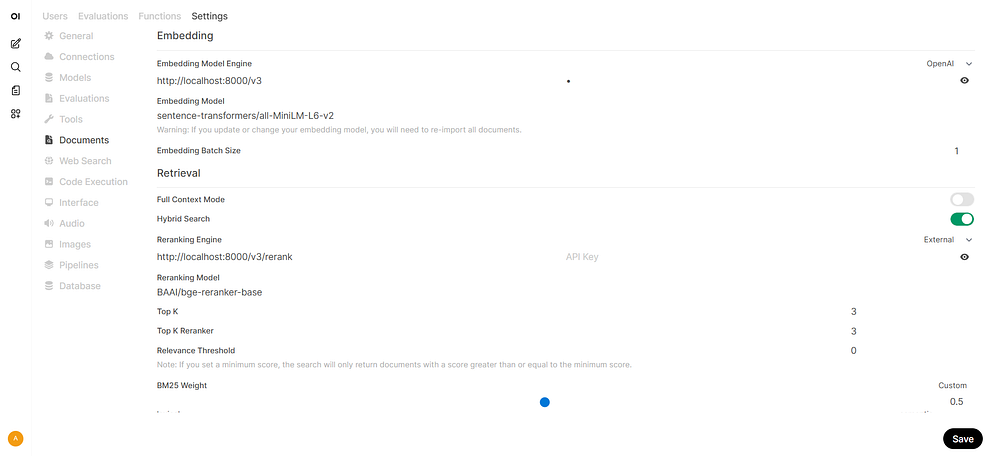
Step 3: Knowledge Base#
Prepare the Documentation
The documentation used in this demo is open-webui/docs. Download and extract it to get the folder.
Go to Workspace → Knowledge → + New Knowledge (http://localhost:8080/workspace/knowledge/create)
Name and describe the knowledge base
Click Create Knowledge
Click +Add Content → Upload directory, then select the extracted folder. This will upload all files with suitable extensions.
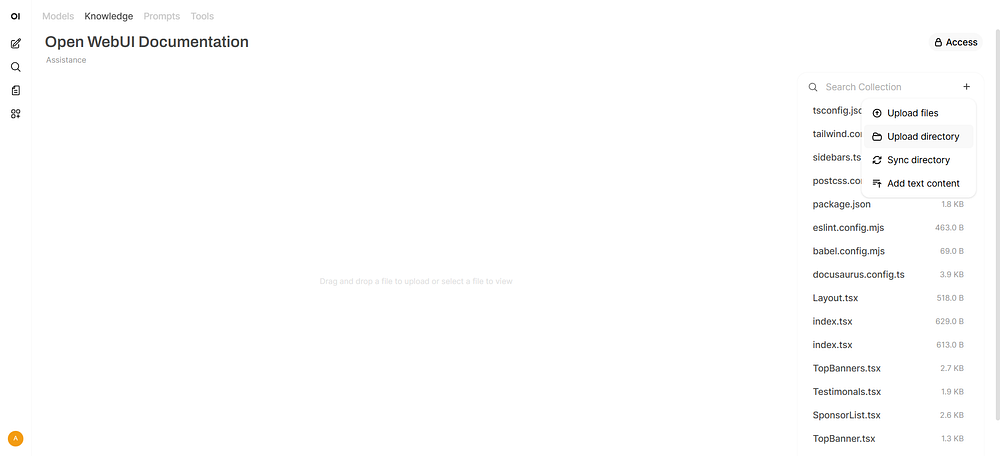
Step 4: Chat with RAG#
Click New Chat. Enter
#symbolSelect documents that appear above the chat box for retrieval. Document icons will appear above Send a Message.
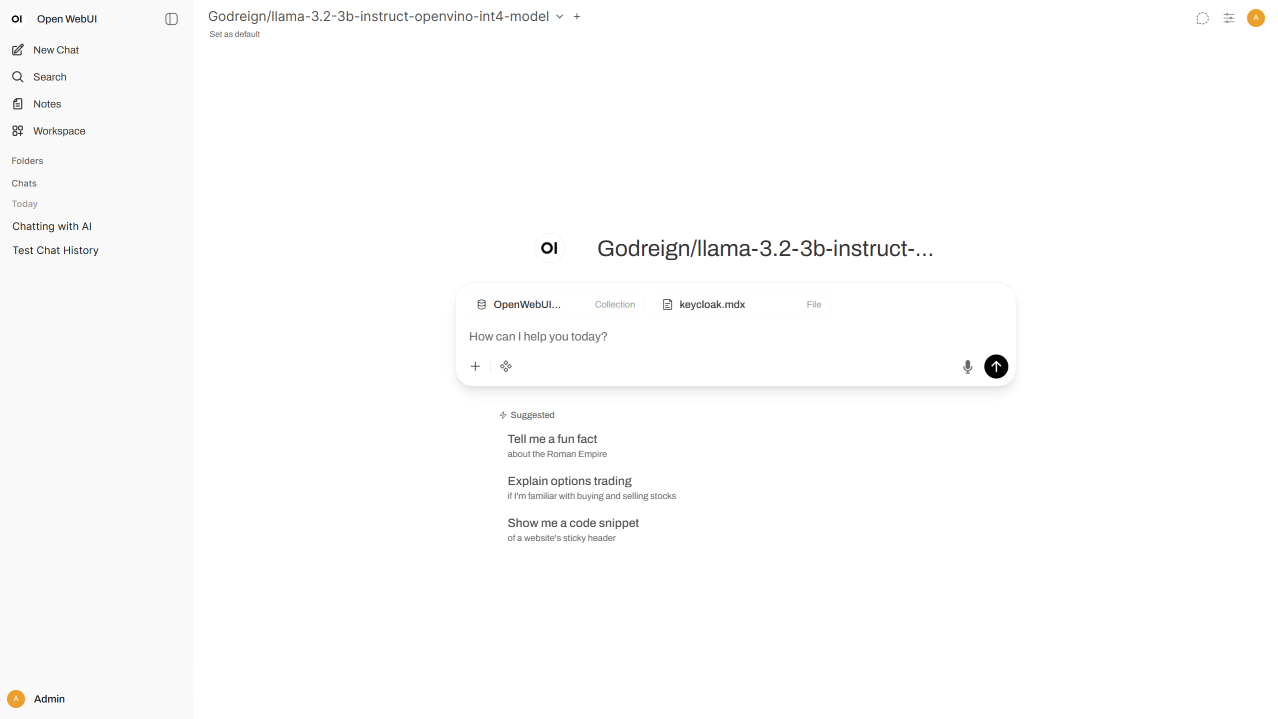
Enter a query and send
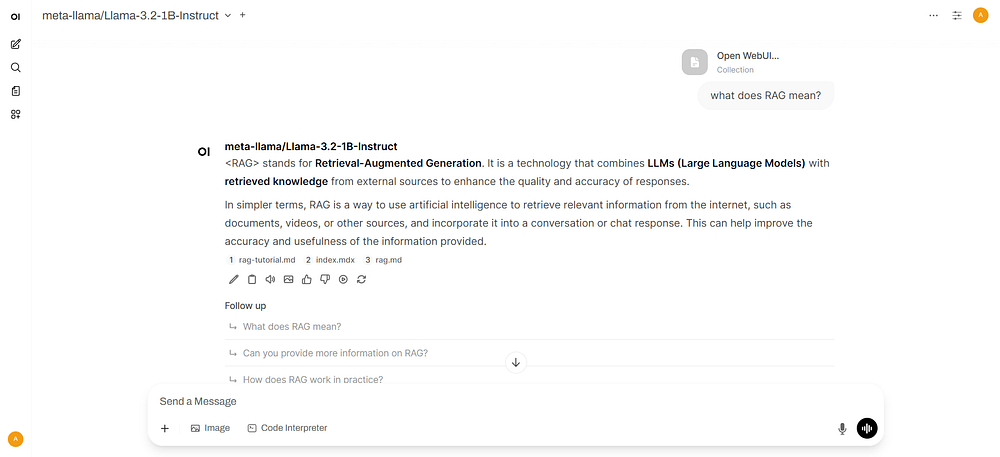
Step 5: RAG-enabled Model#
Go to Workspace → Models → + New Model (http://localhost:8080/workspace/models/create)
Configure the Model:
Name the model
Select a base model from the list
Click Select Knowledge and select a knowledge base for retrieval
Click Save & Create
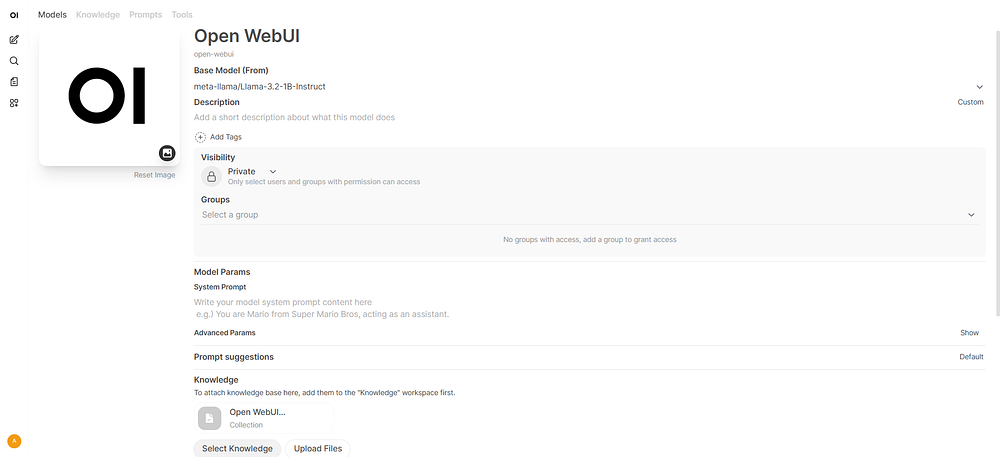
Click the created model and start chatting
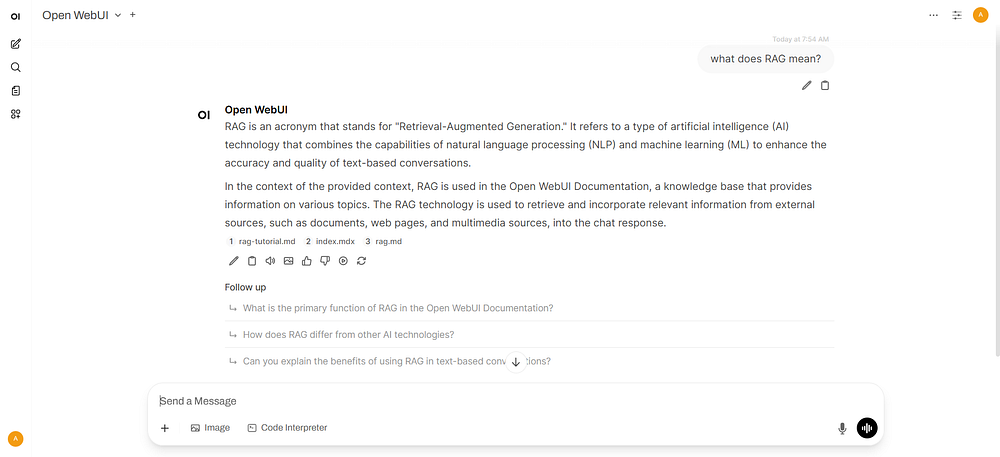
Reference#
https://docs.openvino.ai/2025/model-server/ovms_demos_continuous_batching_rag.html
Image Generation#
Step 1: Model Preparation#
The image generation model used in this demo is OpenVINO/FLUX.1-schnell-int4-ov. Run the ovms with –pull parameter to download and quantize the model:
ovms.exe --pull --source_model OpenVINO/FLUX.1-schnell-int4-ov --model_repository_path models --model_name OpenVINO/FLUX.1-schnell-int4-ov --task image_generation --default_num_inference_steps 3
ovms.exe --add_to_config --config_path models\config.json --model_path OpenVINO\FLUX.1-schnell-int4-ov --model_name OpenVINO/FLUX.1-schnell-int4-ov
docker run --rm -u $(id -u):$(id -g) -v $PWD/models:/models openvino/model_server:weekly --pull --source_model OpenVINO/FLUX.1-schnell-int4-ov --model_repository_path models --model_name OpenVINO/FLUX.1-schnell-int4-ov --task image_generation --default_num_inference_steps 3
docker run --rm -u $(id -u):$(id -g) -v $PWD/models:/models openvino/model_server:weekly --add_to_config --config_path /models/config.json --model_path OpenVINO/FLUX.1-schnell-int4-ov --model_name OpenVINO/FLUX.1-schnell-int4-ov
Keep the model server running or restart it. Here is the basic call to check if it works:
curl http://localhost:8000/v3/images/generations -H "Content-Type: application/json" -d "{\"model\":\"OpenVINO/FLUX.1-schnell-int4-ov\",\"prompt\":\"anime\",\"num_inference_steps\":1,\"size\":\"256x256\",\"response_format\":\"b64_json\"}"
Step 2: Image Generation Setting#
Go to Admin Panel → Settings → Images (http://localhost:8080/admin/settings/images)
Configure OpenAI API:
URL:
http://localhost:8000/v3Put anything in API key
Enable Image Generation (Experimental)
Set Default Model:
OpenVINO/FLUX.1-schnell-int4-ovSet Image Size. Must be in WxH format, example:
256x256
Click Save
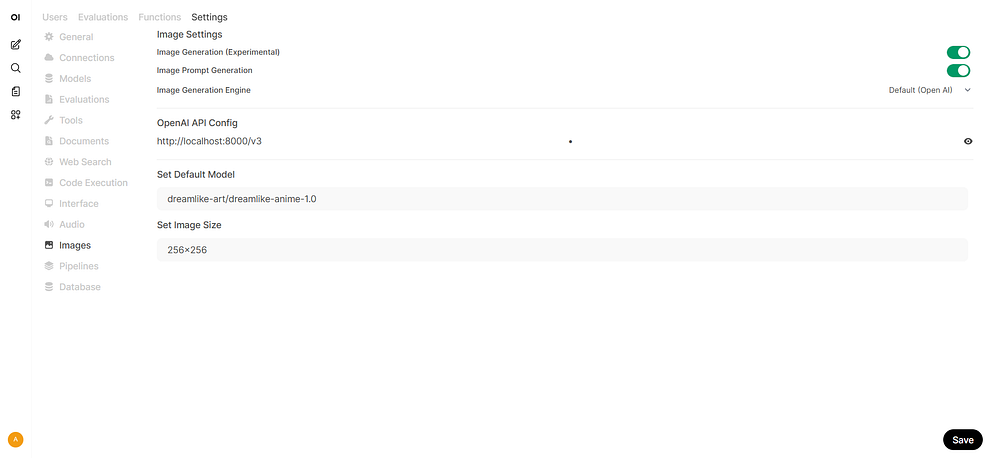
Step 3: Generate Image#
Method 1:
Expand
IntegrationsmenuToggle the Image switch to on
Enter a query and send

Method 2:
Send a query, with or without the Image switch on
After the response has finished generating, it can be edited to a prompt
Click the Picture icon to generate an image
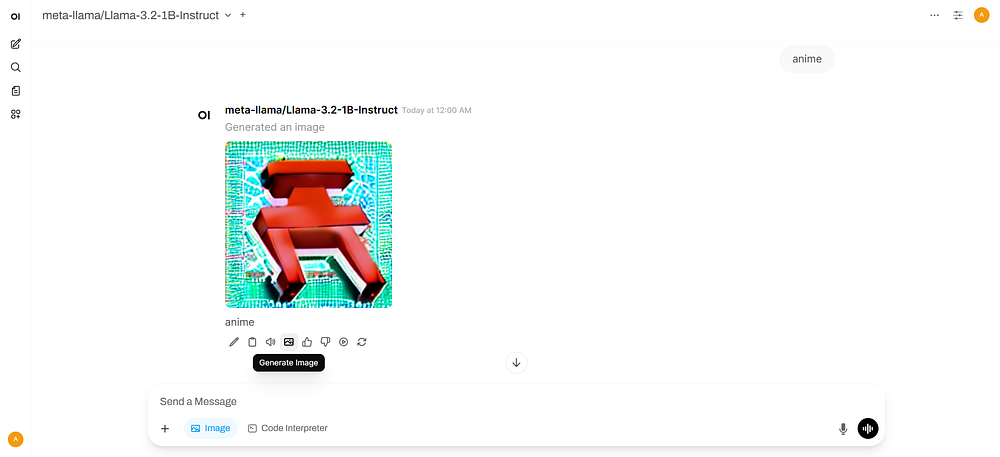
Reference#
https://docs.openvino.ai/2025/model-server/ovms_demos_image_generation.html
https://docs.openwebui.com/features/image-generation-and-editing
VLM#
Step 1: Model Preparation#
The vision language model used in this demo is OpenVINO/InternVL2-2B-int4-ov. Run the ovms with –pull parameter to download and quantize the model:
ovms.exe --pull --source_model OpenVINO/InternVL2-2B-int4-ov --model_repository_path models --model_name OpenVINO/InternVL2-2B-int4-ov --task text_generation
ovms.exe --add_to_config --config_path models\config.json --model_path OpenVINO\InternVL2-2B-int4-ov --model_name OpenVINO/InternVL2-2B-int4-ov
docker run --rm -u $(id -u):$(id -g) -v $PWD/models:/models openvino/model_server:weekly --pull --source_model OpenVINO/InternVL2-2B-int4-ov --model_repository_path models --model_name OpenVINO/InternVL2-2B-int4-ov --task text_generation
docker run --rm -u $(id -u):$(id -g) -v $PWD/models:/models openvino/model_server:weekly --add_to_config --config_path /models/config.json --model_path OpenVINO/InternVL2-2B-int4-ov --model_name OpenVINO/InternVL2-2B-int4-ov
Keep the model server running or restart it. Here is the basic call to check if it works:
curl http://localhost:8000/v3/chat/completions -H "Content-Type: application/json" -d "{ \"model\": \"OpenVINO/InternVL2-2B-int4-ov\", \"messages\":[{\"role\": \"user\", \"content\": [{\"type\": \"text\", \"text\": \"what is in the picture?\"},{\"type\": \"image_url\", \"image_url\": {\"url\": \"http://raw.githubusercontent.com/openvinotoolkit/model_server/refs/heads/releases/2025/4/demos/common/static/images/zebra.jpeg\"}}]}], \"max_completion_tokens\": 100}"
Step 2: Chat with VLM#
Start a New Chat with model set to
OpenVINO/InternVL2-2B-int4-ovClick +More to upload images, by capturing the screen or uploading files. The image used in this demo is http://raw.githubusercontent.com/openvinotoolkit/model_server/refs/heads/releases/2025/4/demos/common/static/images/zebra.jpeg.
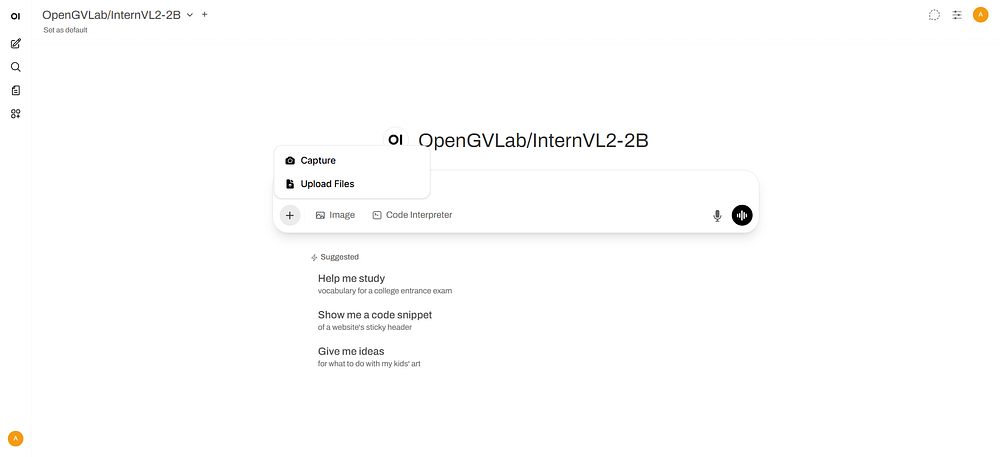 3. Enter a query and send
3. Enter a query and send
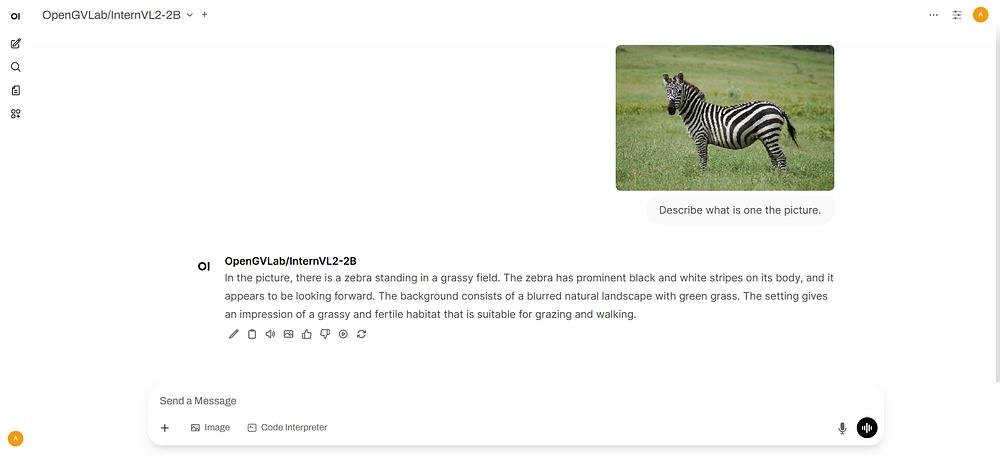
Reference#
https://docs.openvino.ai/2025/model-server/ovms_demos_continuous_batching_vlm.html
AI agent with Tools#
Step 1: Start Tool Server#
Start a OpenAPI tool server available in the openapi-servers repo. The server used in this demo is open-webui/openapi-servers. Run it locally at http://localhost:9000:
pip install mcpo
pip install mcp_weather_server
mcpo --port 9000 -- python -m mcp_weather_server
Step 2: Tools Setting#
Go to Admin Panel → Settings → External Tools
Click +Add Connection
URL:
http://localhost:9000Name the tool
Click Save
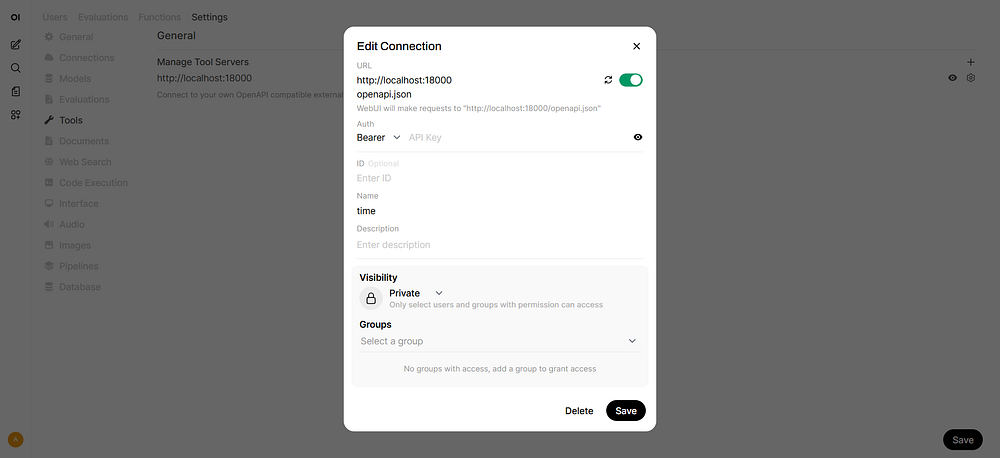
Step 3: Chat with AI Agent#
Click +More and toggle on the tool
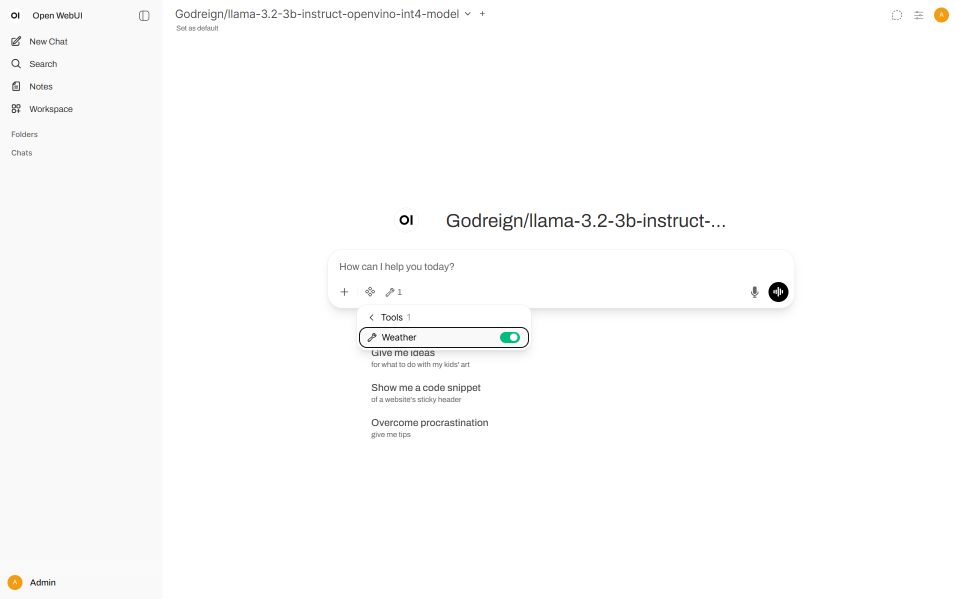
Enter a query and send
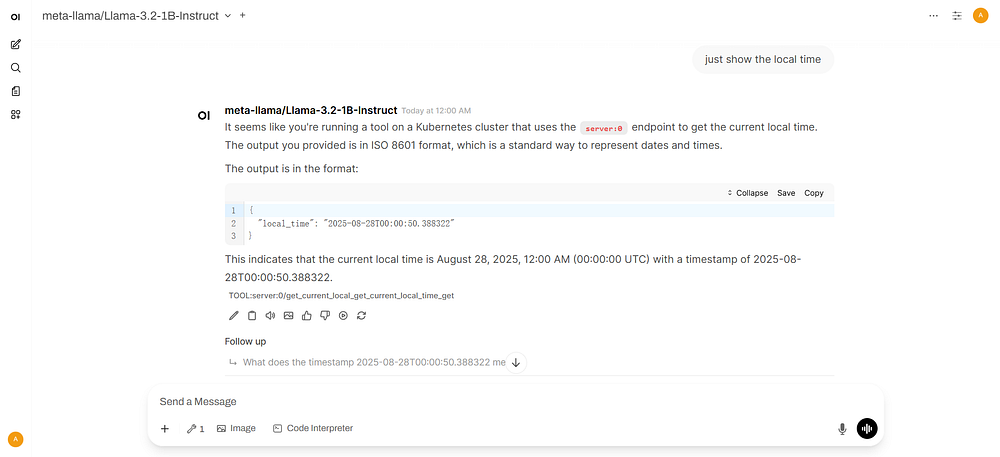
Reference#
https://docs.openwebui.com/features/plugin/tools/openapi-servers/open-webui
Audio#
Note: To ensure audio features work correctly, download FFmpeg and add its executable directory to your system’s
PATHenvironment variable.
Step 1: Models Preparation#
Start by downloading export_models.py script and run it to download and quantize the model for speech generation:
curl https://raw.githubusercontent.com/openvinotoolkit/model_server/refs/heads/releases/2025/4/demos/common/export_models/export_model.py -o export_model.py
pip3 install -r https://raw.githubusercontent.com/openvinotoolkit/model_server/refs/heads/releases/2025/4/demos/common/export_models/requirements.txt
python export_model.py text2speech --source_model microsoft/speecht5_tts --weight-format fp32 --model_name microsoft/speecht5_tts --config_file_path models/config.json --model_repository_path models --vocoder microsoft/speecht5_hifigan
Next, download and add to config model for transcription:
ovms.exe --pull --source_model OpenVINO/whisper-base-fp16-ov --model_repository_path models --task speech2text
ovms.exe --add_to_config --config_path models\config.json --model_path OpenVINO\whisper-base-fp16-ov --model_name OpenVINO/whisper-base-fp16-ov
docker run --rm -u $(id -u):$(id -g) -v $PWD/models:/models openvino/model_server:weekly --pull --source_model OpenVINO/whisper-base-fp16-ov --model_repository_path /models --task speech2text
docker run --rm -u $(id -u):$(id -g) -v $PWD/models:/models openvino/model_server:weekly --add_to_config --config_path /models/config.json --model_path OpenVINO/whisper-base-fp16-ov --model_name OpenVINO/whisper-base-fp16-ov
Step 2: Audio Settings#
Go to Admin Panel → Settings → Audio
Select OpenAI for both engines
URL:
http://localhost:8000/v3Set Engine type to
OpenAISTT Model:
OpenVINO/whisper-base-fp16-ovTTS Model:
microsoft/speecht5_ttsPut anything in API key
Click Save
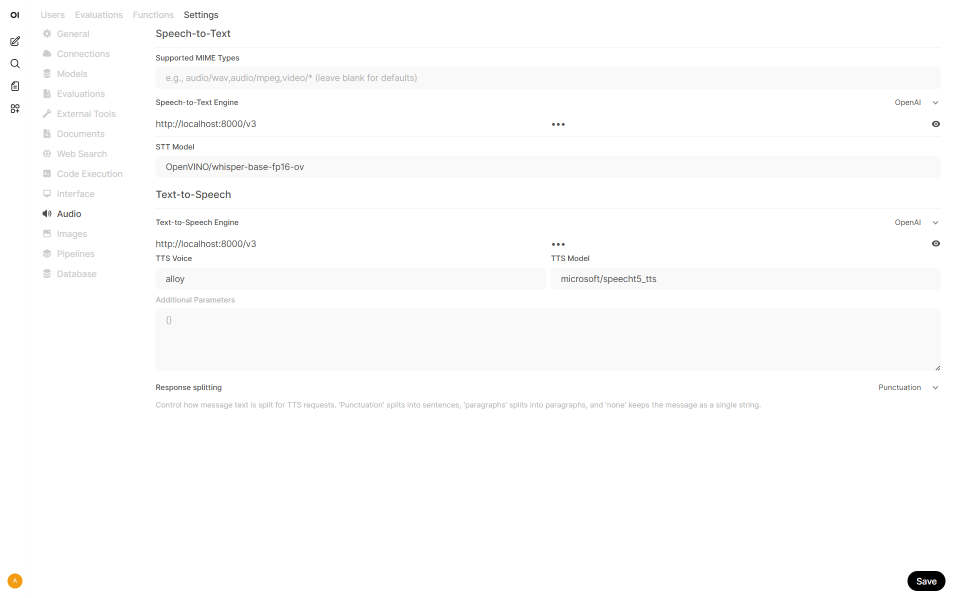
Step 3: Chat with AI Agent#
Click Voice mode icon.
Start talking.
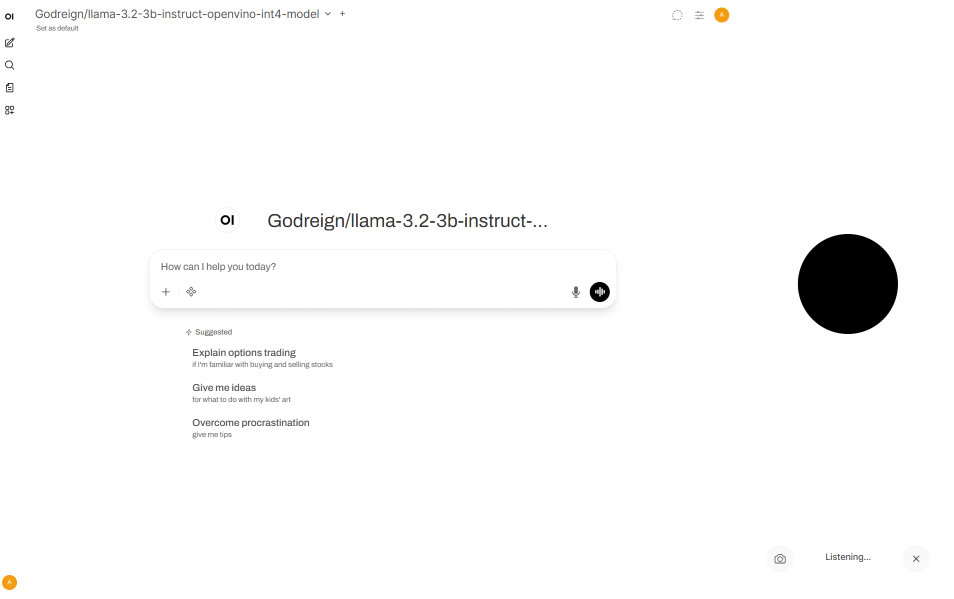
Reference#
https://docs.openwebui.com/features/#%EF%B8%8F-audio-voice–accessibility